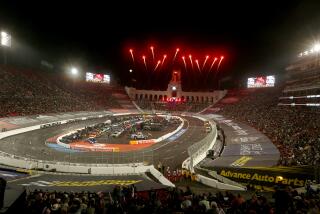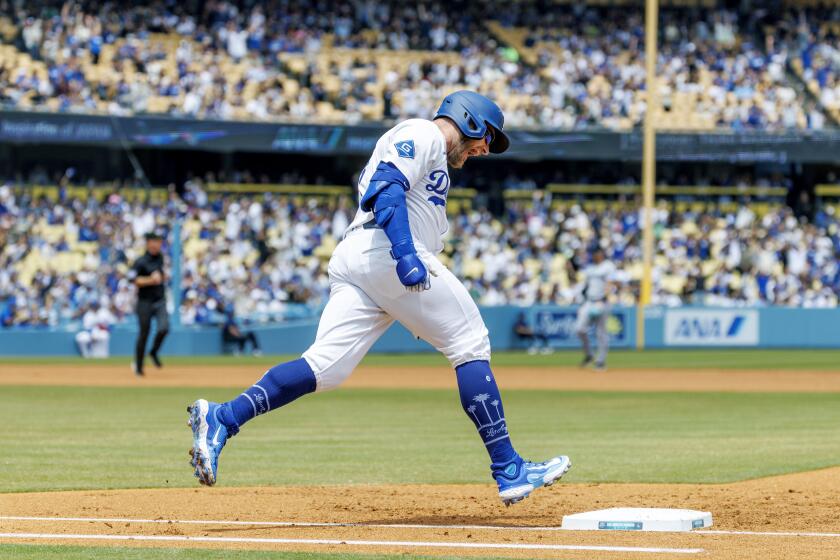NASCAR Garage Too Busy for Many
- Share via
Walking at a brisk pace, Dale Earnhardt Jr. artfully maneuvers his way through a thick crowd of fans waving merchandise to be autographed and begging him to pose for pictures.
A pack of almost 50 people huddles around the back of Jeff Gordon’s hauler, pushing closer and closer to try to grab his attention and his signature. Flashbulbs pop and Sharpie pens are shoved at him as Gordon patiently tries to accommodate everyone.
A NASCAR policy that allows fans access to the garage area has turned the drivers’ time out of the car into a challenge almost as big as the races themselves. As two of the biggest stars in the sport, Earnhardt and Gordon have seen their office space overrun by the average, often overzealous fan.
“I appreciate that it’s a big deal for a fan to come in and meet their favorite driver and get an autograph or a picture because a lot of times it’s the opportunity of a lifetime,” Gordon said. “But they also have to respect that this is our workplace and we’re trying to do a job here.”
Sometimes that’s tough, especially for the top drivers who will fight the pedestrian traffic again this weekend at Phoenix International Raceway.
Simply walking 50 yards from the hauler to the car can take several minutes and requires great skill. Three rules must be followed: never stop walking, be careful not to step on anyone, and scribble your name while you go.
The process has Earnhardt considering hiring security help just to get around.
“When I’m getting ready to go to the drivers’ meeting, I need to account for how big the crowd is and how long it might slow me up,” he said. “There’s no such thing as leaving for the meeting a few minutes before because you’d never make it on time. There’s just so many people along the way.”
NASCAR recognizes the monster its popularity has created and is re-examining criteria for getting a coveted garage pass.
Now, the 43 teams are given six passes to each race to distribute as they please. Every sponsor associated with the teams has a list, usually made up of associates and customers. The drivers have their guests and the host track has its own roster of VIPs.
NASCAR tries to accommodate everyone. The result ranges from 1,500 to 2,000 extra people in the garage area at any given race, said NASCAR spokesman Jim Hunter. After a rash of complaints following the May race in Concord, N.C., NASCAR is reviewing sign-in sheets at every race to determine exactly who gets into the garages.
“It has grown increasingly difficult for a driver to walk from point A to point B without being surrounded by fans looking for autographs,” he said.
NASCAR chairman Bill France Jr. is considering a system that would continue to allow fans in the garage but limit their access to the drivers. One idea would be to allow drivers to sign autographs only at designated times or in the area immediately behind their haulers.
“The sport is built on the fans and the sponsors, so we can’t take that away,” France said. “But I would consider something like a one-hour period, maybe after the final practice, where the drivers go somewhere, sit down and meet their fans and sign for them.
“I’d like to make a project out of how we can make this better without harming what the sport was built on.”
Gordon would like that. He has seen fans fall down trying to catch him and others trip over jackstands. He’s also concerned about hitting people with his car.
The most dangerous time in the garage area is when the cars are coming off the track on a “clean-cut,” when the driver has cut the power and is coasting in with no brakes and little steering.
“I’m surprised we don’t have many incidents. I know I’ve had several close calls after a clean-cut,” Gordon said. “You’re coming in, you can’t stop the car and people walk right in front of you.
“NASCAR has made improvements with security and ropes, but I think they can do a better job.”
Earnhardt doesn’t want fans banned from the garage and doesn’t want to stop accommodating people who pay hundreds or thousands of dollars to support him. But he would like to see a better policing system.
“A lot of them are first-timers in here and they don’t know which way a car is coming, where it is coming from or when practice is starting,” he said. “That makes it dangerous for everyone.”
More to Read
Go beyond the scoreboard
Get the latest on L.A.'s teams in the daily Sports Report newsletter.
You may occasionally receive promotional content from the Los Angeles Times.










